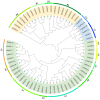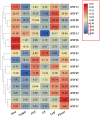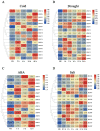Genome-Wide Identification and Expression Analysis of HSF Transcription Factors in Alfalfa (Medicago sativa) under Abiotic Stress
- PMID: 36297789
- PMCID: PMC9609925
- DOI: 10.3390/plants11202763
Genome-Wide Identification and Expression Analysis of HSF Transcription Factors in Alfalfa (Medicago sativa) under Abiotic Stress
Abstract
Alfalfa (Medicago sativa) is one of the most important legume forage species in the world. It is often affected by several abiotic stressors that result in reduced yields and poor growth. Therefore, it is crucial to study the resistance of M. sativa to abiotic stresses. Heat shock transcription factors (HSF) are key players in a number of transcriptional regulatory pathways. These pathways play an essential role in controlling how plants react to different abiotic stressors. Studies on the HSF gene family have been reported in many species but have not yet undergone a thorough analysis in M. sativa. Therefore, in order to identify a more comprehensive set of HSF genes, from the genomic data, we identified 16 members of the MsHSF gene, which were unevenly distributed over six chromosomes. We also looked at their gene architectures and protein motifs, and phylogenetic analysis allowed us to divide them into 3 groups with a total of 15 subgroups. Along with these aspects, we then examined the physicochemical properties, subcellular localization, synteny analysis, GO annotation and enrichment, and protein interaction networks of amino acids. Finally, the analysis of 16 MsHSF genes' expression levels across all tissues and under four abiotic stresses using publicly available RNA-Seq data revealed that these genes had significant tissue-specific expression. Moreover, the expression of most MsHSF genes increased dramatically under abiotic stress, further validating the critical function played by the MsHSF gene family in abiotic stress. These results provided basic information about MsHSF gene family and laid a foundation for further study on the biological role of MsHSF gene in response to stress in M. sativa.
Keywords: HSF gene family; Medicago sativa; abiotic stress; expression profile.
Conflict of interest statement
The authors declare no conflict of interest.
Figures












Similar articles
-
Characterization of the Heat Shock Transcription Factor Family in Medicago sativa L. and Its Potential Roles in Response to Abiotic Stresses.Int J Mol Sci. 2023 Aug 11;24(16):12683. doi: 10.3390/ijms241612683. Int J Mol Sci. 2023. PMID: 37628861 Free PMC article.
-
Genome-wide identification and expression analysis of the Auxin-Response factor (ARF) gene family in Medicago sativa under abiotic stress.BMC Genomics. 2023 Aug 29;24(1):498. doi: 10.1186/s12864-023-09610-z. BMC Genomics. 2023. PMID: 37644390 Free PMC article.
-
Genome-wide identification of the MADS-box transcription factor family in autotetraploid cultivated alfalfa (Medicago sativa L.) and expression analysis under abiotic stress.BMC Genomics. 2021 Aug 7;22(1):603. doi: 10.1186/s12864-021-07911-9. BMC Genomics. 2021. PMID: 34362293 Free PMC article.
-
Genome-Wide Identification of Eucalyptus Heat Shock Transcription Factor Family and Their Transcriptional Analysis under Salt and Temperature Stresses.Int J Mol Sci. 2022 Jul 21;23(14):8044. doi: 10.3390/ijms23148044. Int J Mol Sci. 2022. PMID: 35887387 Free PMC article.
-
Molecular Mechanisms of Alfalfa Response to Abiotic Stresses.Plants (Basel). 2025 Feb 6;14(3):487. doi: 10.3390/plants14030487. Plants (Basel). 2025. PMID: 39943049 Free PMC article. Review.
Cited by
-
Genome-Wide Identification and Expression Analysis of the HSF Gene Family in Ammopiptanthus mongolicus.Curr Issues Mol Biol. 2024 Oct 14;46(10):11375-11393. doi: 10.3390/cimb46100678. Curr Issues Mol Biol. 2024. PMID: 39451558 Free PMC article.
-
A Genome-Wide Analysis and Expression Profile of Heat Shock Transcription Factor (Hsf) Gene Family in Rhododendron simsii.Plants (Basel). 2023 Nov 20;12(22):3917. doi: 10.3390/plants12223917. Plants (Basel). 2023. PMID: 38005814 Free PMC article.
-
Exploring the Heat Shock Transcription Factor (HSF) Gene Family in Ginger: A Genome-Wide Investigation on Evolution, Expression Profiling, and Response to Developmental and Abiotic Stresses.Plants (Basel). 2023 Aug 20;12(16):2999. doi: 10.3390/plants12162999. Plants (Basel). 2023. PMID: 37631210 Free PMC article.
-
Characterization of the Heat Shock Transcription Factor Family in Medicago sativa L. and Its Potential Roles in Response to Abiotic Stresses.Int J Mol Sci. 2023 Aug 11;24(16):12683. doi: 10.3390/ijms241612683. Int J Mol Sci. 2023. PMID: 37628861 Free PMC article.
-
Molecular Biology of Ornamental Plants.Plants (Basel). 2023 Oct 7;12(19):3493. doi: 10.3390/plants12193493. Plants (Basel). 2023. PMID: 37836233 Free PMC article.
References
-
- Song Y., Lv J., Ma Z., Dong W. The mechanism of alfalfa (Medicago sativa L.) response to abiotic stress. Plant Growth Regul. 2019;89:239–249. doi: 10.1007/s10725-019-00530-1. - DOI
Grants and funding
LinkOut - more resources
Full Text Sources

